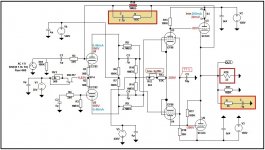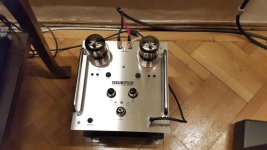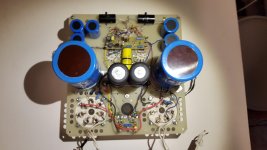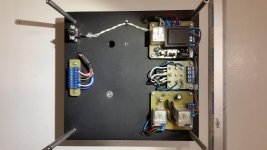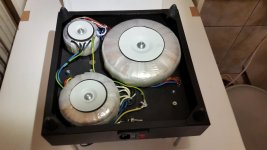Hey all, great topic.. I'm just beginning to put the final schematics into Circuit Maker and then start the buying process of parts.
We were happy to see successful projects with these beasts, some really inspired us (especially using handles - good idea).
Since my father has 4 matched Ulyanov 6C33C-B tubes, we're probably doing a mod/resize onto Class-A pushpull & balanced inputs and try to drive the tubes somewhat cooler. Still in consideration. We'll see.
Cheers.
We were happy to see successful projects with these beasts, some really inspired us (especially using handles - good idea).
Since my father has 4 matched Ulyanov 6C33C-B tubes, we're probably doing a mod/resize onto Class-A pushpull & balanced inputs and try to drive the tubes somewhat cooler. Still in consideration. We'll see.
Cheers.
Hi
I have 4 power supply Boards for Tim Mellows OTL 6C33C Project for sales. All Boards are including an Offset Circuit detector circuit plus all the Phoenix High-Voltage terminals.
https://www.diyaudio.com/forums/swa...lows-otl-power-supply-boards.html#post5941757
Br Walter
I have 4 power supply Boards for Tim Mellows OTL 6C33C Project for sales. All Boards are including an Offset Circuit detector circuit plus all the Phoenix High-Voltage terminals.
https://www.diyaudio.com/forums/swa...lows-otl-power-supply-boards.html#post5941757
Br Walter
More recently, I am stressed by the idea of finding a better tube instead of ef86 in my scheme. That's because over time, the only problem was the premature wear of the two pentodes, which can lead to a collapse when the power tubes remain without bias. I noticed that one of the two pentodes works at the limit in Tim's scheme which can cause wear. What can you suggest?
My first thought is to lower the filament voltage by .5 volts. That usually increases the life of a tube.
More recently, I am stressed by the idea of finding a better tube instead of ef86 in my scheme. That's because over time, the only problem was the premature wear of the two pentodes, which can lead to a collapse when the power tubes remain without bias. I noticed that one of the two pentodes works at the limit in Tim's scheme which can cause wear. What can you suggest?
I didn't trust the JJs or Electro-Harmonix, so my solution was to order 20 NOS 6Ж32П equivalents by Svetlana. I got a job lot for $100 in the Ukraine, but they are plentiful on eBay. I made a basic tube tester, and then matched them myself. I've never had any failures.
BTW, my Tim Mellow OTL has turned out to be a fabulous amp, but of course it's very hard on the electricity bill, so I only use it to give myself an audio treat occasionally. A fan is essential or it will overheat badly. Mine is a "Silent Wings 2" 120mm by "bequiet" of Germany.
Hi Godfrey,
I used Mullards and now I am running some RFTs. I used a lot my OTL as I like how it drives my ESL63 and I am not very much concern about the electricity bill....for the moment. Also, the "hotness" is not an issue in my case, as I changed the input of my Quads to 32 ohms, so the amp is more efficient, the musical power rise and the current lowers at no more than 1,25 amps on peaks. In that matter, I followed the notes and ideas of Patrick Turner, as he used a trafo adapter between OTL and speakers with the primary at 120 ohms.
By the way, did you make any improvement to your OTL?
In my case, after lots of conversations with Tim Mellow (who kindly answered every time even to my most stupid questions) I had done the followingS:
- Power supply was totally separated. one trafo for the main +/- 150V, one for the filaments, and one for the first stage and bias.
- Delay for the main supply, the amp starts with filaments and the first stage/bias, then after 10 min, the main trafo start softly.
- The first stage tail has added a CCS using a 2SK117gr.
The result was an improvement in detail, soundstage and lower response.
Regards,
Victor
I used Mullards and now I am running some RFTs. I used a lot my OTL as I like how it drives my ESL63 and I am not very much concern about the electricity bill....for the moment. Also, the "hotness" is not an issue in my case, as I changed the input of my Quads to 32 ohms, so the amp is more efficient, the musical power rise and the current lowers at no more than 1,25 amps on peaks. In that matter, I followed the notes and ideas of Patrick Turner, as he used a trafo adapter between OTL and speakers with the primary at 120 ohms.
By the way, did you make any improvement to your OTL?
In my case, after lots of conversations with Tim Mellow (who kindly answered every time even to my most stupid questions) I had done the followingS:
- Power supply was totally separated. one trafo for the main +/- 150V, one for the filaments, and one for the first stage and bias.
- Delay for the main supply, the amp starts with filaments and the first stage/bias, then after 10 min, the main trafo start softly.
- The first stage tail has added a CCS using a 2SK117gr.
The result was an improvement in detail, soundstage and lower response.
Regards,
Victor
Last edited:
I can try it, but I think, the emission will lower accordingly.My first thought is to lower the filament voltage by .5 volts. That usually increases the life of a tube.
Thanks.
By the way, did you make any improvement to your OTL?
Not necessarily an improvement in sound quality but as I have the tubes already I am thinking of building this version of the Mellow OTL.
triodeamp2013
Has anyone done this and, if so, how was it?
In my case, after lots of conversations with Tim Mellow (who kindly answered every time even to my most stupid questions) I had done the followingS:
- Power supply was totally separated. one trafo for the main +/- 150V, one for the filaments, and one for the first stage and bias.
- Delay for the main supply, the amp starts with filaments and the first stage/bias, then after 10 min, the main trafo start softly.
- The first stage tail has added a CCS using a 2SK117gr.
The result was an improvement in detail, soundstage and lower response.
That's interesting Victor. For my planned build I am thinking I will use fully regulated power supplies using TomC's maid reg circuit;
21st Century Maida Regulator
Using regulated supplies should reduce the influence of an added CCS but I would still be interested in what you have done to add one to your first stage - do you have a sketch of the changes you made?
Cheers
Ray
I followed the notes and ideas of Patrick Turner, as he used a trafo adapter between OTL and speakers with the primary at 120 ohms.
Regards,
Victor
Hello Victor. No I did not make any improvements or modifications. It's quite beautiful as it is. I don't see the point of using a trafo adaptor - it is no longer an OTL then.
Hi again,
You are right about the adapting trafo, but, in my case (ESL 63) it is there anyway. So I have to manage the situation in the best case the amp can act.
We know the OTL acts better on higher loads, why do not take advantage of the input setup possibility of the ESL 63?
You are right about the adapting trafo, but, in my case (ESL 63) it is there anyway. So I have to manage the situation in the best case the amp can act.
We know the OTL acts better on higher loads, why do not take advantage of the input setup possibility of the ESL 63?
Using regulated supplies should reduce the influence of an added CCS but I would still be interested in what you have done to add one to your first stage - do you have a sketch of the changes you made?
Cheers
Ray[/QUOTE]
I don't see the connection between regulating the supply of the first stage and adding the ccs on the long tail phase inverter. But here you are what I have done in that case.
Cheers
Ray[/QUOTE]
I don't see the connection between regulating the supply of the first stage and adding the ccs on the long tail phase inverter. But here you are what I have done in that case.
Attachments
triodeamp2013
Has anyone done this and, if so, how was it?
Ray[/QUOTE]
I use that amp since 2015 and I can't find something better....in conjunction with my ESL63.
There is some clue in the beginning but I managed to find solutions as:
- main PSU capacitors quality matters a lot
- matching the 6c33c is a must but is not easy
- matching the ef86 also is a must
- the quality of the ecc83 is very important in the sound result (now I use some old MINIWAT with best results)
- The quality of the input capacitors matters a lot.
- the amp as a whole thing, must run more than 100 hours till it starts delighting the ears
My goal is getting rid of the two input capacitors by using an input balancing transformer, but.....I was not able til mow to find the practical mode to do it.
Some photos of the naked thing:
Has anyone done this and, if so, how was it?
Ray[/QUOTE]
I use that amp since 2015 and I can't find something better....in conjunction with my ESL63.
There is some clue in the beginning but I managed to find solutions as:
- main PSU capacitors quality matters a lot
- matching the 6c33c is a must but is not easy
- matching the ef86 also is a must
- the quality of the ecc83 is very important in the sound result (now I use some old MINIWAT with best results)
- The quality of the input capacitors matters a lot.
- the amp as a whole thing, must run more than 100 hours till it starts delighting the ears
My goal is getting rid of the two input capacitors by using an input balancing transformer, but.....I was not able til mow to find the practical mode to do it.
Some photos of the naked thing:
Attachments
Last edited:
I don't see the connection between regulating the supply of the first stage and adding the ccs on the long tail phase inverter. But here you are what I have done in that case.
Thanks Victor. I'm not an electronics engineer and it may be that I have misunderstood something; I thought that by regulating the plate voltage you are in essence influencing the current at the cathode. Anyway, thanks for sharing your schematic.
Ray
I use that amp since 2015 and I can't find something better....in conjunction with my ESL63.
There is some clue in the beginning but I managed to find solutions as:
- main PSU capacitors quality matters a lot
- matching the 6c33c is a must but is not easy
- matching the ef86 also is a must
- the quality of the ecc83 is very important in the sound result (now I use some old MINIWAT with best results)
- The quality of the input capacitors matters a lot.
- the amp as a whole thing, must run more than 100 hours till it starts delighting the ears
My goal is getting rid of the two input capacitors by using an input balancing transformer, but.....I was not able til mow to find the practical mode to do it.
Some photos of the naked thing:
Nice project Victor.
I am also interested in the possibility of the balanced input to the Mellow OTL (mentioned in the original article) and eliminating the input caps but in my case I have available DACs with balanced outputs using high quality Lundahl transformers so it may be possible as there is no DC present on the input signals. I can use digital volume control (via HQ Player) and/or maybe a balanced attenuator.
I see you have also removed the bias current ammeters and use a low value resistor instead. I plan to do the same and install a socket to allow a multimeter to be used to periodically check the bias current.
The link I included in my post was different to your build in using Russian sub-miniature tubes instead of the ECC83 and EF86s, it is that change I was asking if anyone had tried? I already have the specified subminiature tubes so it may be worth a try.
BTW, I'll be using the amp with 16ohm speakers, which should give it a slightly easier life.
72 hours of cooking time for new tubes, with the plate, grid and cathodes shorted together and connected to one side of the filament as recommended is going to help...
If use 6c19p, you can reduce some heaters consumption. E.g. 16 * 6.3W ~=100W against 4* 60W =240W more than 50% saving.
240 watts from the wall outlet just to light the heaters up for 4 tubes. Whew!
3,5 x 12,6 x 4 =176.4 VA Ac
72 hours of cooking time for new tubes, with the plate, grid and cathodes shorted together and connected to one side of the filament as recommended is going to help...
I already have done this and it works. The result was more stability and less arcing tubes. I found one bad tube from 100 cooked.
This is what I am looking for also, but I couldn't find a way to manage the place of the NFB after eliminating the two input capacitors.Nice project Victor.
I am also interested in the possibility of the balanced input to the Mellow OTL
- Home
- Amplifiers
- Tubes / Valves
- OTL designed by Tim Mellow with 4 6C33C?
